
New Brunswick is a city in and the seat of government of Middlesex County, in the U.S. state of New Jersey. The city is the home of Rutgers University. The city is both a regional commercial hub for central New Jersey and a prominent and growing commuter town for residents commuting to New York City within the New York metropolitan area. New Brunswick is on the Northeast Corridor rail line, 27 miles (43 km) southwest of Manhattan. The city is located on the southern banks of the Raritan River in the Raritan Valley region.
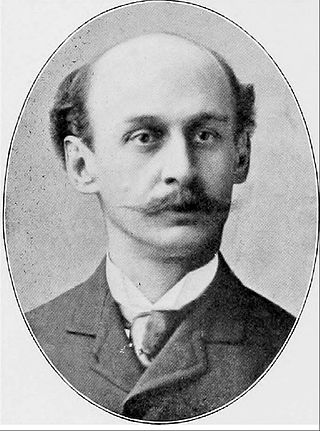
Henry Janeway Hardenbergh was an American architect, best known for his hotels and apartment buildings, and as a "master of a new building form — the skyscraper."

Rutgers Preparatory School is a private, coeducational, college preparatory day school established in 1766. The school educates students in pre-kindergarten through twelfth grade, located on a 41-acre (0.17 km2) campus along the banks of the Delaware and Raritan Canal in the Somerset section of Franklin Township, in Somerset County, New Jersey, United States. Established in 1766, Rutgers Preparatory School is the oldest independent school in the state of New Jersey and the 16th-oldest in the country.
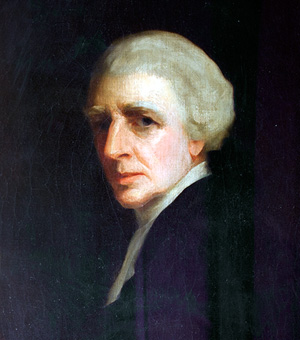
Jacob Rutsen Hardenbergh was an American Dutch Reformed clergyman, colonial and state legislator, and educator. Hardenbergh was a founder of Queen's College—now Rutgers, The State University of New Jersey—in 1766, and was later appointed as the college's first president.

New Brunswick Theological Seminary is a Reformed Christian seminary with its main campus in New Brunswick, New Jersey. It was founded in 1784 and is one of the oldest seminaries in the United States. It is a seminary of the Reformed Church in America (RCA), a mainline Reformed Protestant denomination in Canada and the United States that follows the theological tradition and Christian practice of John Calvin. First established in New York City under the leadership of the Rev. John Henry Livingston, who instructed aspiring ministers in his home, the seminary established its presence in New Brunswick in 1810. Although a separate institution, the seminary's early development in New Brunswick was closely connected with that of Rutgers University before establishing its own campus in the city in 1856. Since 1986, the seminary has also offered classes at a satellite location on the grounds of St. John's University in the Jamaica neighborhood of Queens, New York.
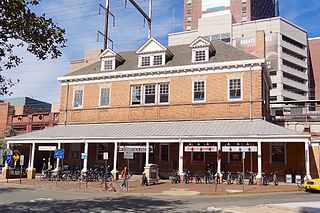
New Brunswick station is a railroad station in New Brunswick, New Jersey. It serves Amtrak and NJ Transit trains on the Northeast Corridor. The station is located at the intersection of Easton Avenue and French and Albany Streets, near the College Avenue Campus of Rutgers University.

Old Queens is the oldest extant building at Rutgers University and is the symbolic heart of the university's campus in New Brunswick in Middlesex County, New Jersey in the United States. Rutgers, the eighth-oldest college in the United States, was founded in 1766 during the American colonial period as Queen's College. Queen's College was named for Charlotte of Mecklenburg-Strelitz, the daughter of a German duke who became the queen consort of British king George III. Old Queens is located on a six-acre hilltop city block bounded by Somerset Street, Hamilton Street, College Avenue and George Street that was previously an apple orchard. Donated to the college in 1807 by James Parker, Jr., this city block become known the Queen's Campus and is the historic core of the university. Because of this, by metonymy, the name "Old Queens" came to be used as a reference to Rutgers College and is often invoked as an allusive reference to the university or to its administration.

Voorhees Mall is a large grassy area with stately shade trees on a block of about 28 acres (0.11 km²) located on the College Avenue Campus of Rutgers University near downtown New Brunswick, New Jersey. An eclectic mix of architectural styles, Voorhees Mall is lined by many historic academic buildings. The block is bound by Hamilton Street, George Street (north), College Avenue (south) and Seminary Place (west). At the mall's western end, across Seminary Place, is the campus of the New Brunswick Theological Seminary, whose history is intertwined with the early history of Rutgers University. Across Hamilton Street is the block called Old Queens, the seat of the university.
Rutgers University is an institution of higher learning with campuses across the State of New Jersey its main flagship campus in New Brunswick and Piscataway, and two other campuses in the cities of Newark and Camden, New Jersey.

Saint Peter the Apostle Church is a historic Roman Catholic church at 94 Somerset Street in New Brunswick, Middlesex County, New Jersey, United States.

St. Bernard's Church and Parish House is a historic church complex located at 88 Claremont Road in the borough of Bernardsville in Somerset County, New Jersey. This Episcopal Church in the Episcopal Diocese of New Jersey is named after St. Bernard of Clairvaux. It was added to the National Register of Historic Places on September 6, 2006, for its significance in architecture.

The Sophia Astley Kirkpatrick Memorial Chapel, known as Kirkpatrick Chapel, is the chapel to Rutgers, The State University of New Jersey and located on the university's main campus in New Brunswick, New Jersey in the United States. Kirkpatrick Chapel is among the university's oldest extant buildings, and one of six buildings located on a historic section of the university's College Avenue Campus in New Brunswick known as the Queens Campus. Built in 1872 when Rutgers was a small, private liberal arts college, the chapel was designed by architect Henry Janeway Hardenbergh at the beginning of his career. Hardenbergh, a native of New Brunswick, was the great-great-grandson of Rutgers' first president, the Rev. Jacob Rutsen Hardenbergh. It was the third of three projects that Hardenbergh designed for the college.

Geology Hall is a historic building on the Queens Campus of Rutgers University, in New Brunswick, New Jersey. It was built from April 1871 to June 1872 to house various science classes and the Rutgers Geology Museum. The museum was established in 1872 by George Hammell Cook, Rutgers' then professor of geology, with a collection of specimens whose assembly began in the 1830s under Cook's predecessor, Lewis Caleb Beck. As classes and offices moved out of the hall, the museum expanded until it occupied the entire hall by the mid-20th century. In 1973, the hall was added to the New Jersey and National Register of Historic Places (NRHP) with Old Queens, President's House, Van Nest Hall, Daniel S. Schanck Observatory, the Kirkpatrick Chapel, and Winants Hall as part of the Old Queens Campus historic district.
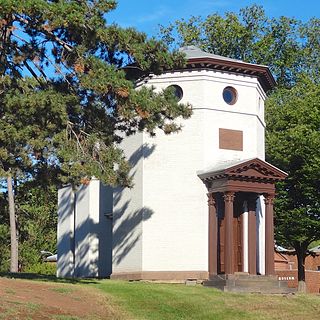
The Daniel S. Schanck Observatory is an historical astronomical observatory on the Queens Campus of Rutgers University in New Brunswick, New Jersey, United States, and is tied for the seventh oldest observatory in the US alongside the Vassar College Observatory. It is located on George Street near the corner with Hamilton Street, opposite the parking lot adjacent to Kirkpatrick Chapel, and to the northeast of Old Queens and Geology Hall.

The Queens Campus or Old Queens Campus is a historic section of the College Avenue Campus of Rutgers, The State University of New Jersey in New Brunswick, New Jersey, in the United States.

The Peithessophian Society of Rutgers College was a student literary and debating society founded in 1825 at Rutgers College in New Brunswick, New Jersey. Founded by Professor James Spencer Canon after Rutgers College reopened after years of financial difficulty and a brief closing, it was one of two such societies at campus in the nineteenth-century—the other being the Philoclean Society. The name "Peithessophian" is derived from the Ancient Greek meaning "persuasiveness of wisdom."
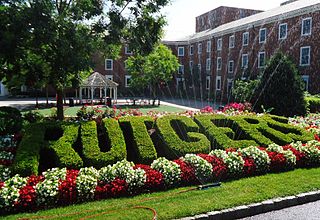
College Avenue is the oldest campus of Rutgers University – New Brunswick, in New Brunswick, New Jersey, U.S. It includes the historic seat of the university, known as Old Queens and the campus of the New Brunswick Theological Seminary. Many classes are taught in the Voorhees Mall area, also home to the Zimmerli Art Museum. It is within walking distance of shops, restaurants, and theaters in downtown New Brunswick and is served by Rutgers Campus Buses, a zero-fare bus network.

The Demarest House is a historic building at 542 George Street in New Brunswick, New Jersey on the campus of Rutgers University. It was documented by the Historic American Buildings Survey in 1960. The house was later added to the National Register of Historic Places on August 10, 1977 for its significance in architecture, education, and social history.

The James Bishop House, known as the Bishop House, is a historic building on the College Avenue campus of Rutgers University in New Brunswick, New Jersey. Bishop House was built in 1852 for James Bishop, a prominent businessman and politician from New Brunswick in the latter half of 19th century. Located off of and facing College Avenue, the Bishop House is an example of an Italianate, or "Italian Villa" style mansion, popular from the 1850s to late 1870s in New Brunswick. Due to the building's significant associations with architecture, education, industry, politics and religion, it was added to the National Register of Historic Places on July 12, 1976.

The Daniel Robert House is a historic house located at 25 West End Avenue in Somerville in Somerset County, New Jersey. The house was built in 1888 for Daniel Robert (1840–1908) by the architectural firm Lambert & Bunnell based on Gothic revival style houses designed by the architect Alexander Jackson Davis. It now serves as the Somerville Borough Hall and the Somerville Public Library. The building was added to the National Register of Historic Places on March 5, 2008 for its significance in architecture from 1888 to 1939.






















